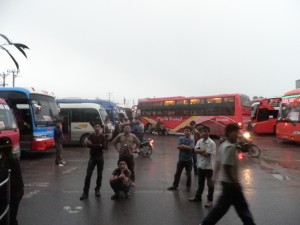Got on a minivan at 8am to Phonsavan. (110,000 kip~USD$13).
![P4045691 [640x480]](http://journey26.com/blog/wp-content/uploads/2010/04/P4045691-640x480-300x225.jpg)
Phonsavan is the capital of Xieng Khuang province. It’s considered quite a small town with only 60,000 people and is famous for the site Plain of Jars which is only 15km away. Xieng Khuang province was the most bombed area in Laos by the Americans during the Vietnam War. There is a big population of Hmong in this area. The Hmong are one of the 3 bigger ethnic group in Laos.
The road to Phonsavan is the windiest road I have seen so far. We passed by some local villages on the road
![P4045693 [640x480]](http://journey26.com/blog/wp-content/uploads/2010/04/P4045693-640x480-300x225.jpg)
and noticed that Laos was still very behind in its development.
Infrastructure and education are important factors for a country to become competitive and Laos lack both of those. Many villages still don’t have water and electricity. The people here weren’t exposed much to the world and still keep their culture and way of life.
Slash and burn are common here. Laotians burn some land in order to grow crops.
![P4045689 [640x480]](http://journey26.com/blog/wp-content/uploads/2010/04/P4045689-640x480-300x225.jpg)
The minivan stopped at a small town of the intersection between road to Vientienne and road to Phonsavan.
There is a small market at the intersection.
![P4045698 [640x480]](http://journey26.com/blog/wp-content/uploads/2010/04/P4045698-640x480-300x225.jpg)
Had sticky rice for lunch (20,000Kip~USD$2.50).
![P4045702 [640x480]](http://journey26.com/blog/wp-content/uploads/2010/04/P4045702-640x480-300x225.jpg)
It seems to me that even though Laos is a poor country but food is not cheap here compared to its neighboring countries. I am sure that I am paying the local price. Taking an exception to taxes, supply and demand are more important factors that determine prices of goods than the economic condition of a country. So even though the income of the locals is low, but they are still paying more for food. This is similar to a few middle eastern countries I visited few months ago where food wasn’t that cheap.
Arrived at Phonsavan at around 3.30pm and stayed at Saibadee guesthouse (30,000 Kip~USD$4)
![P4045704 [640x480]](http://journey26.com/blog/wp-content/uploads/2010/04/P4045704-640x480-300x225.jpg)
![P4045730 [640x480]](http://journey26.com/blog/wp-content/uploads/2010/04/P4045730-640x480-300x225.jpg)
A cute Laotian girl, daughter of the guesthouse owner
![P4045708 [640x480]](http://journey26.com/blog/wp-content/uploads/2010/04/P4045708-640x480-300x225.jpg)
A Hmong lady
![P4045705 [640x480]](http://journey26.com/blog/wp-content/uploads/2010/04/P4045705-640x480-300x225.jpg)
There are still a lot of UXO (Unexploded Ordnance) in this region and every year there are still people who are killed and injured by the UXO.
Visited the UXO Center.
![P4045712 [640x480]](http://journey26.com/blog/wp-content/uploads/2010/04/P4045712-640x480-300x225.jpg)
From 1965 to 1973, the Americans dropped 1.36 metric tones of bomb with 250 million bomblets. This is equivalent with half a tonne of bomb for everyone in the country.
![P4045713 [640x480]](http://journey26.com/blog/wp-content/uploads/2010/04/P4045713-640x480-225x300.jpg)
Northern Laos was bombed because the Pathet Laos communist was there and Southern Laos was bombed to disrupt the supply line used by the Northern Vietnamese in the Vietnam war. Xieng Khuang province was the most bombed area in Laos.
Sample of some bombs
![P4045715 [640x480]](http://journey26.com/blog/wp-content/uploads/2010/04/P4045715-640x480-225x300.jpg)
Street in Phonsavon
![P4045721 [640x480]](http://journey26.com/blog/wp-content/uploads/2010/04/P4045721-640x480-300x225.jpg)
![P4045719 [640x480]](http://journey26.com/blog/wp-content/uploads/2010/04/P4045719-640x480-300x225.jpg)
There is a Chinese market in Phonsavan.
![P4045722 [640x480]](http://journey26.com/blog/wp-content/uploads/2010/04/P4045722-640x480-300x225.jpg)
![P4045725 [640x480]](http://journey26.com/blog/wp-content/uploads/2010/04/P4045725-640x480-300x225.jpg)
Most of the Chinese in Phonsavan come from Hunan province which is at Southern China. There are approximately 900 Chinese in this small town of 40,000 people, the Chinese are everywhere.
Chicken market
![P4045729 [640x480]](http://journey26.com/blog/wp-content/uploads/2010/04/P4045729-640x480-300x225.jpg)
Noodles for dinner (15,000 Kip~USD$2)
![P4045731 [640x480]](http://journey26.com/blog/wp-content/uploads/2010/04/P4045731-640x480-300x225.jpg)
![P4095947 [640x480]](http://journey26.com/blog/wp-content/uploads/2010/04/P4095947-640x480-300x225.jpg)
![P4095978 [640x480]](http://journey26.com/blog/wp-content/uploads/2010/04/P4095978-640x480-300x225.jpg)
![P4095995 [640x480]](http://journey26.com/blog/wp-content/uploads/2010/04/P4095995-640x480-300x225.jpg)
![P4095953 [640x480]](http://journey26.com/blog/wp-content/uploads/2010/04/P4095953-640x480-300x225.jpg)
![P4095954 [640x480]](http://journey26.com/blog/wp-content/uploads/2010/04/P4095954-640x480-300x225.jpg)
![P4095955 [640x480]](http://journey26.com/blog/wp-content/uploads/2010/04/P4095955-640x480-300x225.jpg)
![P4095957 [640x480]](http://journey26.com/blog/wp-content/uploads/2010/04/P4095957-640x480-300x225.jpg)
![P4095960 [640x480]](http://journey26.com/blog/wp-content/uploads/2010/04/P4095960-640x480-225x300.jpg)
![P4095963 [640x480]](http://journey26.com/blog/wp-content/uploads/2010/04/P4095963-640x480-300x225.jpg)
![P4095965 [640x480]](http://journey26.com/blog/wp-content/uploads/2010/04/P4095965-640x480-300x225.jpg)
![P4095967 [640x480]](http://journey26.com/blog/wp-content/uploads/2010/04/P4095967-640x480-300x225.jpg)
![P4095973 [640x480]](http://journey26.com/blog/wp-content/uploads/2010/04/P4095973-640x480-300x225.jpg)
![P4095982 [640x480]](http://journey26.com/blog/wp-content/uploads/2010/04/P4095982-640x480-300x225.jpg)
![P4095987 [640x480]](http://journey26.com/blog/wp-content/uploads/2010/04/P4095987-640x480-300x225.jpg)
![P4095989 [640x480]](http://journey26.com/blog/wp-content/uploads/2010/04/P4095989-640x480-300x225.jpg)
![P4095990 [640x480]](http://journey26.com/blog/wp-content/uploads/2010/04/P4095990-640x480-300x225.jpg)
![P4095993 [640x480]](http://journey26.com/blog/wp-content/uploads/2010/04/P4095993-640x480-300x225.jpg)
![P4075842 [640x480]](http://journey26.com/blog/wp-content/uploads/2010/04/P4075842-640x480-300x225.jpg)
![P4075821 [640x480]](http://journey26.com/blog/wp-content/uploads/2010/04/P4075821-640x480-300x225.jpg)
![P4075823 [640x480]](http://journey26.com/blog/wp-content/uploads/2010/04/P4075823-640x480-300x225.jpg)
![P4075824 [640x480]](http://journey26.com/blog/wp-content/uploads/2010/04/P4075824-640x480-300x225.jpg)
![P4075827 [640x480]](http://journey26.com/blog/wp-content/uploads/2010/04/P4075827-640x480-300x225.jpg)
![P4075830 [640x480]](http://journey26.com/blog/wp-content/uploads/2010/04/P4075830-640x480-225x300.jpg)
![P4075832 [640x480]](http://journey26.com/blog/wp-content/uploads/2010/04/P4075832-640x480-300x225.jpg)
![P4075837 [640x480]](http://journey26.com/blog/wp-content/uploads/2010/04/P4075837-640x480-300x225.jpg)
![P4075839 [640x480]](http://journey26.com/blog/wp-content/uploads/2010/04/P4075839-640x480-300x225.jpg)
![P4075840 [640x480]](http://journey26.com/blog/wp-content/uploads/2010/04/P4075840-640x480-300x225.jpg)
![P4075841 [640x480]](http://journey26.com/blog/wp-content/uploads/2010/04/P4075841-640x480-300x225.jpg)
![P4075844 [640x480]](http://journey26.com/blog/wp-content/uploads/2010/04/P4075844-640x480-300x225.jpg)
![P4075845 [640x480]](http://journey26.com/blog/wp-content/uploads/2010/04/P4075845-640x480-300x225.jpg)
![P4075846 [640x480]](http://journey26.com/blog/wp-content/uploads/2010/04/P4075846-640x480-300x225.jpg)
![P4075847 [640x480]](http://journey26.com/blog/wp-content/uploads/2010/04/P4075847-640x480-300x225.jpg)
![P4075853 [640x480]](http://journey26.com/blog/wp-content/uploads/2010/04/P4075853-640x480-300x225.jpg)
![P4075854 [640x480]](http://journey26.com/blog/wp-content/uploads/2010/04/P4075854-640x480-300x225.jpg)
![P4075857 [640x480]](http://journey26.com/blog/wp-content/uploads/2010/04/P4075857-640x480-300x225.jpg)
![P4075860 [640x480]](http://journey26.com/blog/wp-content/uploads/2010/04/P4075860-640x480-300x225.jpg)
![P4075864 [640x480]](http://journey26.com/blog/wp-content/uploads/2010/04/P4075864-640x480-300x225.jpg)
![P4075865 [640x480]](http://journey26.com/blog/wp-content/uploads/2010/04/P4075865-640x480-300x225.jpg)
![P4075875 [640x480]](http://journey26.com/blog/wp-content/uploads/2010/04/P4075875-640x480-300x225.jpg)
![P4075877 [640x480]](http://journey26.com/blog/wp-content/uploads/2010/04/P4075877-640x480-300x225.jpg)
![P4075879 [640x480]](http://journey26.com/blog/wp-content/uploads/2010/04/P4075879-640x480-300x225.jpg)

![P4065788 [640x480]](http://journey26.com/blog/wp-content/uploads/2010/04/P4065788-640x480-300x225.jpg)
![P4065784 [640x480]](http://journey26.com/blog/wp-content/uploads/2010/04/P4065784-640x480-300x225.jpg)
![P4065781 [640x480]](http://journey26.com/blog/wp-content/uploads/2010/04/P4065781-640x480-300x225.jpg)
![P4065791 [640x480]](http://journey26.com/blog/wp-content/uploads/2010/04/P4065791-640x480-300x225.jpg)
![P4065790 [640x480]](http://journey26.com/blog/wp-content/uploads/2010/04/P4065790-640x480-300x225.jpg)
![P4065794 [640x480]](http://journey26.com/blog/wp-content/uploads/2010/04/P4065794-640x480-300x225.jpg)
![P4065795 [640x480]](http://journey26.com/blog/wp-content/uploads/2010/04/P4065795-640x4801-300x225.jpg)
![P4065797 [640x480]](http://journey26.com/blog/wp-content/uploads/2010/04/P4065797-640x480-300x225.jpg)
![P4065811 [640x480]](http://journey26.com/blog/wp-content/uploads/2010/04/P4065811-640x480-300x225.jpg)
![P4055732 [640x480]](http://journey26.com/blog/wp-content/uploads/2010/04/P4055732-640x4801-300x225.jpg)
![P4055736 [640x480]](http://journey26.com/blog/wp-content/uploads/2010/04/P4055736-640x480-300x225.jpg)
![P4055737 [640x480]](http://journey26.com/blog/wp-content/uploads/2010/04/P4055737-640x480-300x225.jpg)
![P4055738 [640x480]](http://journey26.com/blog/wp-content/uploads/2010/04/P4055738-640x480-300x225.jpg)
![P4055745 [640x480]](http://journey26.com/blog/wp-content/uploads/2010/04/P4055745-640x480-300x225.jpg)
![P4055747 [640x480]](http://journey26.com/blog/wp-content/uploads/2010/04/P4055747-640x480-300x225.jpg)
![P4055748 [640x480]](http://journey26.com/blog/wp-content/uploads/2010/04/P4055748-640x480-300x225.jpg)
![P4055760 [640x480]](http://journey26.com/blog/wp-content/uploads/2010/04/P4055760-640x480-300x225.jpg)
![P4055755 [640x480]](http://journey26.com/blog/wp-content/uploads/2010/04/P4055755-640x480-300x225.jpg)
![P4055757 [640x480]](http://journey26.com/blog/wp-content/uploads/2010/04/P4055757-640x480-300x225.jpg)
![P4055758 [640x480]](http://journey26.com/blog/wp-content/uploads/2010/04/P4055758-640x480-300x225.jpg)
![P4055762 [640x480]](http://journey26.com/blog/wp-content/uploads/2010/04/P4055762-640x480-300x225.jpg)
![P4055765 [640x480]](http://journey26.com/blog/wp-content/uploads/2010/04/P4055765-640x480-300x225.jpg)
![P4055766 [640x480]](http://journey26.com/blog/wp-content/uploads/2010/04/P4055766-640x480-300x225.jpg)
![P4055772 [640x480]](http://journey26.com/blog/wp-content/uploads/2010/04/P4055772-640x480-300x225.jpg)
![P4055774 [640x480]](http://journey26.com/blog/wp-content/uploads/2010/04/P4055774-640x480-300x225.jpg)
![P4045691 [640x480]](http://journey26.com/blog/wp-content/uploads/2010/04/P4045691-640x480-300x225.jpg)
![P4045693 [640x480]](http://journey26.com/blog/wp-content/uploads/2010/04/P4045693-640x480-300x225.jpg)
![P4045689 [640x480]](http://journey26.com/blog/wp-content/uploads/2010/04/P4045689-640x480-300x225.jpg)
![P4045698 [640x480]](http://journey26.com/blog/wp-content/uploads/2010/04/P4045698-640x480-300x225.jpg)
![P4045702 [640x480]](http://journey26.com/blog/wp-content/uploads/2010/04/P4045702-640x480-300x225.jpg)
![P4045704 [640x480]](http://journey26.com/blog/wp-content/uploads/2010/04/P4045704-640x480-300x225.jpg)
![P4045730 [640x480]](http://journey26.com/blog/wp-content/uploads/2010/04/P4045730-640x480-300x225.jpg)
![P4045708 [640x480]](http://journey26.com/blog/wp-content/uploads/2010/04/P4045708-640x480-300x225.jpg)
![P4045705 [640x480]](http://journey26.com/blog/wp-content/uploads/2010/04/P4045705-640x480-300x225.jpg)
![P4045712 [640x480]](http://journey26.com/blog/wp-content/uploads/2010/04/P4045712-640x480-300x225.jpg)
![P4045713 [640x480]](http://journey26.com/blog/wp-content/uploads/2010/04/P4045713-640x480-225x300.jpg)
![P4045715 [640x480]](http://journey26.com/blog/wp-content/uploads/2010/04/P4045715-640x480-225x300.jpg)
![P4045721 [640x480]](http://journey26.com/blog/wp-content/uploads/2010/04/P4045721-640x480-300x225.jpg)
![P4045719 [640x480]](http://journey26.com/blog/wp-content/uploads/2010/04/P4045719-640x480-300x225.jpg)
![P4045722 [640x480]](http://journey26.com/blog/wp-content/uploads/2010/04/P4045722-640x480-300x225.jpg)
![P4045725 [640x480]](http://journey26.com/blog/wp-content/uploads/2010/04/P4045725-640x480-300x225.jpg)
![P4045729 [640x480]](http://journey26.com/blog/wp-content/uploads/2010/04/P4045729-640x480-300x225.jpg)
![P4045731 [640x480]](http://journey26.com/blog/wp-content/uploads/2010/04/P4045731-640x480-300x225.jpg)
![P4035607 [640x480]](http://journey26.com/blog/wp-content/uploads/2010/04/P4035607-640x480-225x300.jpg)
![P4035608 [640x480]](http://journey26.com/blog/wp-content/uploads/2010/04/P4035608-640x480-300x225.jpg)
![P4035612 [640x480]](http://journey26.com/blog/wp-content/uploads/2010/04/P4035612-640x480-300x225.jpg)
![P4035616 [640x480]](http://journey26.com/blog/wp-content/uploads/2010/04/P4035616-640x480-300x225.jpg)
![P4035619 [640x480]](http://journey26.com/blog/wp-content/uploads/2010/04/P4035619-640x480-300x225.jpg)
![P4035620 [640x480]](http://journey26.com/blog/wp-content/uploads/2010/04/P4035620-640x480-300x225.jpg)
![P4035622 [640x480]](http://journey26.com/blog/wp-content/uploads/2010/04/P4035622-640x480-300x225.jpg)
![P4035623 [640x480]](http://journey26.com/blog/wp-content/uploads/2010/04/P4035623-640x480-300x225.jpg)
![P4035629 [640x480]](http://journey26.com/blog/wp-content/uploads/2010/04/P4035629-640x480-300x225.jpg)
![P4035643 [640x480]](http://journey26.com/blog/wp-content/uploads/2010/04/P4035643-640x480-300x225.jpg)
![P4035644 [640x480]](http://journey26.com/blog/wp-content/uploads/2010/04/P4035644-640x480-300x225.jpg)
![P4035646 [640x480]](http://journey26.com/blog/wp-content/uploads/2010/04/P4035646-640x480-300x225.jpg)
![P4035647 [640x480]](http://journey26.com/blog/wp-content/uploads/2010/04/P4035647-640x480-300x225.jpg)
![P4035653 [640x480]](http://journey26.com/blog/wp-content/uploads/2010/04/P4035653-640x480-300x225.jpg)
![P4035657 [640x480]](http://journey26.com/blog/wp-content/uploads/2010/04/P4035657-640x480-300x225.jpg)
![P4035660 [640x480]](http://journey26.com/blog/wp-content/uploads/2010/04/P4035660-640x480-300x225.jpg)
![P4035662 [640x480]](http://journey26.com/blog/wp-content/uploads/2010/04/P4035662-640x480-300x225.jpg)
![P4035666 [640x480]](http://journey26.com/blog/wp-content/uploads/2010/04/P4035666-640x480-300x225.jpg)
![P4035671 [640x480]](http://journey26.com/blog/wp-content/uploads/2010/04/P4035671-640x480-225x300.jpg)
![P4035672 [640x480]](http://journey26.com/blog/wp-content/uploads/2010/04/P4035672-640x480-300x225.jpg)
![P4025565 [640x480]](http://journey26.com/blog/wp-content/uploads/2010/04/P4025565-640x480-225x300.jpg)
![P4025566 [640x480]](http://journey26.com/blog/wp-content/uploads/2010/04/P4025566-640x480-300x225.jpg)
![P4025573 [640x480]](http://journey26.com/blog/wp-content/uploads/2010/04/P4025573-640x480-300x225.jpg)
![P4025575 [640x480]](http://journey26.com/blog/wp-content/uploads/2010/04/P4025575-640x480-300x225.jpg)
![P4025580 [640x480]](http://journey26.com/blog/wp-content/uploads/2010/04/P4025580-640x480-300x225.jpg)
![P4025581 [640x480]](http://journey26.com/blog/wp-content/uploads/2010/04/P4025581-640x480-300x225.jpg)
![P4025584 [640x480]](http://journey26.com/blog/wp-content/uploads/2010/04/P4025584-640x480-300x225.jpg)
![P4025587 [640x480]](http://journey26.com/blog/wp-content/uploads/2010/04/P4025587-640x480-300x225.jpg)
![P4025590 [640x480]](http://journey26.com/blog/wp-content/uploads/2010/04/P4025590-640x480-300x225.jpg)
![P4025592 [640x480]](http://journey26.com/blog/wp-content/uploads/2010/04/P4025592-640x480-300x225.jpg)
![P4025594 [640x480]](http://journey26.com/blog/wp-content/uploads/2010/04/P4025594-640x480-300x225.jpg)
![P4025595 [640x480]](http://journey26.com/blog/wp-content/uploads/2010/04/P4025595-640x480-300x225.jpg)
![P4025597 [640x480]](http://journey26.com/blog/wp-content/uploads/2010/04/P4025597-640x480-300x225.jpg)
![P4025606 [640x480]](http://journey26.com/blog/wp-content/uploads/2010/04/P4025606-640x480-300x225.jpg)
![P4015551 [640x480]](http://journey26.com/blog/wp-content/uploads/2010/04/P4015551-640x480-300x225.jpg)
![P4015552 [640x480]](http://journey26.com/blog/wp-content/uploads/2010/04/P4015552-640x480-300x225.jpg)
![P4015555 [640x480]](http://journey26.com/blog/wp-content/uploads/2010/04/P4015555-640x480-300x225.jpg)
![P4015558 [640x480]](http://journey26.com/blog/wp-content/uploads/2010/04/P4015558-640x480-300x225.jpg)
![P4015559 [640x480]](http://journey26.com/blog/wp-content/uploads/2010/04/P4015559-640x480-300x225.jpg)
![P4015560 [640x480]](http://journey26.com/blog/wp-content/uploads/2010/04/P4015560-640x480-300x225.jpg)
![P4025571 [640x480]](http://journey26.com/blog/wp-content/uploads/2010/04/P4025571-640x480-300x225.jpg)
![P4015563 [640x480]](http://journey26.com/blog/wp-content/uploads/2010/04/P4015563-640x480-300x225.jpg)
![P3315504 [640x480]](http://journey26.com/blog/wp-content/uploads/2010/03/P3315504-640x480-300x225.jpg)
![P3315503 [640x480]](http://journey26.com/blog/wp-content/uploads/2010/03/P3315503-640x480-300x225.jpg)
![P3315510 [640x480]](http://journey26.com/blog/wp-content/uploads/2010/03/P3315510-640x480-300x225.jpg)
![P3315548 [640x480]](http://journey26.com/blog/wp-content/uploads/2010/03/P3315548-640x480-300x225.jpg)
![P3315511 [640x480]](http://journey26.com/blog/wp-content/uploads/2010/03/P3315511-640x480-300x225.jpg)
![P3315513 [640x480]](http://journey26.com/blog/wp-content/uploads/2010/03/P3315513-640x480-300x225.jpg)
![P3315514 [640x480]](http://journey26.com/blog/wp-content/uploads/2010/03/P3315514-640x480-300x225.jpg)
![P3315515 [640x480]](http://journey26.com/blog/wp-content/uploads/2010/03/P3315515-640x480-300x225.jpg)
![P3315517 [640x480]](http://journey26.com/blog/wp-content/uploads/2010/03/P3315517-640x480-300x225.jpg)
![P3315518 [640x480]](http://journey26.com/blog/wp-content/uploads/2010/03/P3315518-640x480-300x225.jpg)
![P3315520 [640x480]](http://journey26.com/blog/wp-content/uploads/2010/03/P3315520-640x480-300x225.jpg)
![P3315530 [640x480]](http://journey26.com/blog/wp-content/uploads/2010/03/P3315530-640x480-300x225.jpg)
![P3315531 [640x480]](http://journey26.com/blog/wp-content/uploads/2010/03/P3315531-640x480-300x225.jpg)
![P3315533 [640x480]](http://journey26.com/blog/wp-content/uploads/2010/03/P3315533-640x480-300x225.jpg)
![P3315523 [640x480]](http://journey26.com/blog/wp-content/uploads/2010/03/P3315523-640x480-300x225.jpg)
![P3315545 [640x480]](http://journey26.com/blog/wp-content/uploads/2010/03/P3315545-640x480-300x225.jpg)
![P3315546 [640x480]](http://journey26.com/blog/wp-content/uploads/2010/03/P3315546-640x480-300x225.jpg)
![P3315547 [640x480]](http://journey26.com/blog/wp-content/uploads/2010/03/P3315547-640x480-225x300.jpg)
![P3305482 [640x480]](http://journey26.com/blog/wp-content/uploads/2010/04/P3305482-640x480-300x225.jpg)
![P3305443 [640x480]](http://journey26.com/blog/wp-content/uploads/2010/04/P3305443-640x480-300x225.jpg)
![P3305444 [640x480]](http://journey26.com/blog/wp-content/uploads/2010/04/P3305444-640x480-300x225.jpg)
![P3305450 [640x480]](http://journey26.com/blog/wp-content/uploads/2010/04/P3305450-640x480-300x225.jpg)
![P3305452 [640x480]](http://journey26.com/blog/wp-content/uploads/2010/04/P3305452-640x480-300x225.jpg)
![P3305455 [640x480]](http://journey26.com/blog/wp-content/uploads/2010/04/P3305455-640x4801-300x225.jpg)
![P3305457 [640x480]](http://journey26.com/blog/wp-content/uploads/2010/03/P3305457-640x480-300x225.jpg)
![P3305461 [640x480]](http://journey26.com/blog/wp-content/uploads/2010/04/P3305461-640x480-300x225.jpg)
![P3305462 [640x480]](http://journey26.com/blog/wp-content/uploads/2010/04/P3305462-640x480-300x225.jpg)
![P3305463 [640x480]](http://journey26.com/blog/wp-content/uploads/2010/04/P3305463-640x480-300x225.jpg)
![P3305466 [640x480]](http://journey26.com/blog/wp-content/uploads/2010/04/P3305466-640x480-300x225.jpg)
![P3305474 [640x480]](http://journey26.com/blog/wp-content/uploads/2010/04/P3305474-640x480-300x225.jpg)
![P3305478 [640x480]](http://journey26.com/blog/wp-content/uploads/2010/04/P3305478-640x480-300x225.jpg)
![P3315507 [640x480]](http://journey26.com/blog/wp-content/uploads/2010/03/P3315507-640x480-300x225.jpg)
![P3305481 [640x480]](http://journey26.com/blog/wp-content/uploads/2010/04/P3305481-640x480-300x225.jpg)
![P3305479 [640x480]](http://journey26.com/blog/wp-content/uploads/2010/04/P3305479-640x480-300x225.jpg)
![P3305485 [640x480]](http://journey26.com/blog/wp-content/uploads/2010/04/P3305485-640x480-300x225.jpg)
![P3305489 [640x480]](http://journey26.com/blog/wp-content/uploads/2010/03/P3305489-640x480-300x225.jpg)
![P3305490 [640x480]](http://journey26.com/blog/wp-content/uploads/2010/03/P3305490-640x480-300x225.jpg)
![P3305494 [640x480]](http://journey26.com/blog/wp-content/uploads/2010/03/P3305494-640x480-300x225.jpg)